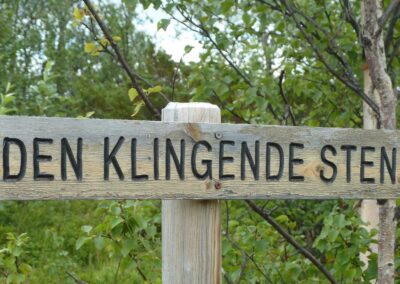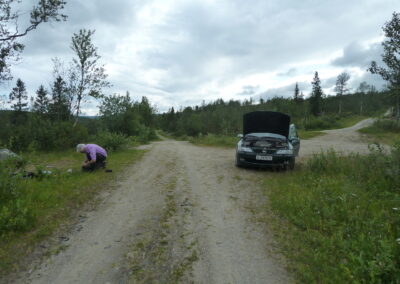The Sounding Stone in Ålen
Type: Ringing stone
Local navme: Den klingende sten
Locality
County: Trøndelag
Municipality: Holtålen
Location: Holden (Holla) Skiing Stadium, Øvre Ålen
The stone is located south of Ålen center, in the direction of Glåmos. If you come driving from the south on National Road 30: Eleven kilometers north of Glåmos, the road crosses over to the west side of the railway, and further, after about 700 meters, you turn left—at the sign Skistadion (‘Ski Stadium’). After 150 meters you come to an intersection, where the stone is visible and signposted a few meters east of the road. If you travel southwards from Ålen Center, the exit to the ski stadium comes after nine kilometers.
Description
This is a rather small stone, almost triangular seen from above. It does not measure more than a meter in any direction. At the top there are a couple of clear, deep cup marks resulting from strokes. When you strike it, you hear a high-pitched sound with several harmonics, but no clear frequency comes through the somewhat metallic sound. The pitch is the same no matter where you hit.
Like many other ringing stones, this is a glacial erratic, which has come from the bedrock in the east. Gurli Meyer at the NGU (Geological Survey of Norway) visited the Singing Stone in the summer of 2020 and described its geology in a Facebook-post: «The stone consists of the minerals quartz, feldspar and hornblende, but also garnet and magnetite. Geologists are not sure whether the rock is amphibolite or granitic gneiss … The answer remains unanswered, because NGU’s researchers will not take samples of ‘Den klingende sten’.
Cultural history and tradition
The Sounding Stone is well known in Ålen. It is located by the old royal road and has remained there since the road was opened in 1779. A local historian from Ålen told that an old schoolteacher from the village believed that there were several similar stones on the east side of the valley, and that this stone had originated from the area by the Lake Feragen. However, it is unclear whether the schoolteacher believed that it had been transported by humans or by the inland ice … It is indeed possible to move such a stone manually, even though it was probably larger earlier. Several stories tell that it has been divided in two–either into two equal parts, or that a smaller piece has been chipped off—in an attempt to find out the mystery of the sound. According to one source, a sample was sent to NGU for analysis many years ago. Another story says that some young people thought that there were cavities in the stone, and that they blew it up with dynamite to find out. Furthermore, it is said that the Sounding Stone had better sound in the past. Interestingly, this is a commonly reported in villages with ringing stones. There is no tradition about the actual use of the stone, except that children used to cycle there to throw pebbles at it.
Sources: Oppunder fjellbandet No. 4, 1982 and Ålen historielag. Thanks to Gurli Meyer.





